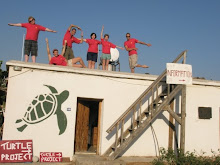


I awoke this lunch time to find a number of missed calls on my phone and a lot of banter in the goat shed about a dead turtle and the press. Apparently a deceased loggerhead had been found on Alagadi this morning and caused some commotion with the local press and the volunteers after their mornings work on the North Coast. The team had decided to bury the large adult female at the back of the beach. With no pressing engagements this afternoon we decided to unearth the girl to conduct an autopsy. We loaded her into the back of the truck and carried her highly pressurised carcass into the goat-shed garden. Obviously dead for some days, her bloated body was hissing with gasses of decomposition, particularly notable was a break in the carapace towards the tail where gasses and innards were oozing, possibly a hit from a jet ski, as we are seeing these increasingly at Alagadi. With the turtle on her back we removed the plastron (ventral shell) and volunteers gathered around, close to vomiting from the smell. We removed the lungs and analysed the gastro-intestinal tract. The turtle certainly did not starve as the stomach and intestine were full with over 2kg of decomposing food. We analysed this and found the majority of the diet to consist of sponge, with many shells from various species of crabs. We also found tell tail remnants of whelks, the operculum doors that close these shells off to predators, these were from large whelks the hard opercula around the size of a thumb nail but the rest of the shell digested. We found a small piece of polythene in the intestine; clear evidence that litter on the beaches and in the sea is affecting the turtles, though this was not the probable cause of death, more likely the rupture form an impact to the posterior of the carapace.
At weekends we see jet skis travelling at great speed up and down Alagadi where turtles are aggregating to breed. Although no tags were found on this adult female and she was not carrying eggs at the time of death, if she had survived to breed at Alagadi she would have been one of 16 loggerhead females recorded this season, so 6.25% of the 2009 Alagadi breeding population. We can not afford to loose breeding adults like this and more needs to be done to prevent jet skis and motor boats from illegally using waters off prime nesting beaches such as Alagadi. After all Alagadi is the 5th most important nesting beach for the green turtle in the Mediterranean and is a hugely important conservation area for both species. An exlusion zone around the designated "Specially Protected Area" has been ignored for some years now.
We are conducting beach cleans on Alagadi every Monday and locals have been getting involved. We also hand out bin bags out on Sundays and speak to local bathers, encouraging them to take their litter off the beach on departure. If people would like to help us on Monday beach cleans we meet at the goat shed at 5pm.
Robin,
Chief Officer Kaplumbaga

No comments:
Post a Comment